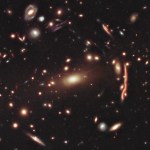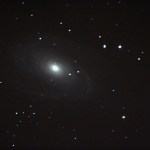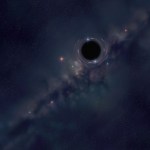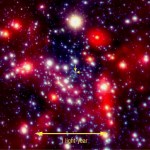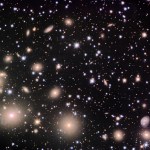Black Holes
"Dream no small dreams, for they have no power to move the hearts of men." -Johann Wolfgang von Goethe
Welcome back to yet another Messier Monday here on Starts With A Bang! Each Monday, we highlight one of the 110 deep-sky objects that make up the Messier catalogue, showing you where and how to find it in the sky and telling you a bit about the history and the physics/astrophysics behind it. Each one tells its own unique story, and today's distant wonder is no exception.
Image credit: Rich Richins, of all 110 Messier objects (in no particular order).
On a virtually moonless night like…
The Kavli Institute for Theoretical Physics is currently holding a "Rapid Response Workshop" on Black Holes: Complementarity, Fuzz, or Fire?, August 19-30.
Organizers: Raphael Bousso (UCB), Samir Mathur (OSU), Rob Myers (PI), Joe Polchinski (KITP), Lenny Susskind (Stanford)
The lunch talk today is Lenny Susskind "Inside Black Holes"
That talk will be available on video, audio and podcast feeds soon
The general session talks from the Fuzz, or Fire are available as they become available at the link above.
Visiting lovely KITP for the A Universe of Black Holes programme, and specifically the associated "Massive Black Holes: Birth, Growth and Impact" workshop.
As usual the talks will (eventually) be posted on line, both slides and web, but in the mean time I will be semi-transcribing my semi-coherent stream-of-consciousness thoughts on the issues.
And we are off, with new KITP Director Lars Bildsten welcoming the hordes.
As is typical, about half the attendees are noobs and have not visited KITP before.
Are they in for a treat.
Marta Volonteri (IAP), one of the workshop organizers, leads off…
“You wait for a gem in an endless sea of blah.” -Lawrence Grossman
On the one hand, we have General Relativity, our theory of space, time, and gravity.
Image credit: Wikimedia commons user Johnstone; Earth from NASA's Galileo mission.
It describes the Universe on both large and small scales perfectly, from the hot Big Bang to our cold accelerating expansion, from vast superclusters of galaxies down to the interiors of black holes.
Image credit: NASA, ESA, M. Postman (STScI), and the CLASH Team.
But General Relativity doesn't tell us everything. It doesn't tell us, for example,…
"According to the special theory of relativity nothing can travel faster than light, so that if light cannot escape, nothing else can either. The result would be a black hole: a region of space-time from which it is not possible to escape to infinity." -Stephen Hawking
You may have encountered objects that are the same size as one another, but have very different masses.
Image credit: Basic Science Supplies / © Accelerate Media.
This is because they're made out of different elements. The higher you go in the periodic table, the larger and more massive your individual atoms are, and so…
"When you look at the stars and the galaxy, you feel that you are not just from any particular piece of land, but from the solar system." -Kalpana Chawla
Welcome to this week's Messier Monday, where I pick a new object out of the original catalogue of 110 "faint fuzzies" designed to help comet-hunters avoid confusion with these fixed, extended night sky objects.
Image credit: The Messier Objects by Alistair Symon, from 2005-2009.
In previous weeks, we've focused on a variety of objects, including a globular cluster, an open star cluster, a supernova remnant and an active star-forming nebula…
“If... then my old theory is completely toast,” says astrophysicist Steinn Sigurdsson of Pennsylvania State University. “This is a really nice piece of work.”
Nice Nature paper coming out tomorrow by Jay Strader et al
on a pair of flat spectrum ultra-faint radio sources in the core of M22.
The sources are consistent with being ~ 20 solar mass black holes, accreting at a low rate from, well, something.
Maybe...
Best candidates yet in the Milky Way globulars.
M22 has a somewhat unusual structure (massive fluffy core) in a way that several authors have suggested might be a signature of black…
Applications are invited for a postdoctoral scholar position to work with Prof. Mike Eracleous and collaborators. The successful applicant will join a team working to identify close, supermassive binary black holes through a combination of observational tests. The postdoctoral scholar will be expected to plan and carry out observations related to this project and lead the effort of analyzing the data and publishing the results.
A Ph.D. in astronomy, physics, or a related field is required, and research experience on active galactic nuclei is highly desirable. In addition, experience with the…
"There is a single light of science, and to brighten it anywhere is to brighten it everywhere." -Isaac Asimov
One of the most spectacular and successful ideas of the 20th Century was Einstein's General Relativity, or the idea that matter and energy determines the curvature of spacetime, and the curvature of spacetime in turn determines how gravitation works.
Image credit: Hyper-Mathematics - Uzayzaman / Spacetime.
From the orbits of planets to the bending of starlight, General Relativity governs all gravitational phenomena in the Universe, and accurately describes every observation we've…
"Black holes, which have no memory, are said to contain the earliest memories of the universe, and the most recent, too, while at the same time obliterating all memory by obliterating all its embodiments. Such paradoxes characterize these strange galactic monsters, for whom creation is destruction, death life, chaos order." -Robert Coover
Our Milky Way, the swath of light and dark that dominates the darkest skies here on Earth, contains a huge variety of stars: large and small, red and blue, from young to old to ancient.
Image credit: ESO / Serge Brunier, Frederic Tapissier, The World At…
"They say 'A flat ocean is an ocean of trouble. And an ocean of waves... can also be trouble.' So, it's like, that balance. You know, it's that great Oriental way of thinking, you know, they think they've tricked you, and then, they have." -Nigel Tufnel
Black holes* are some of the most perplexing objects in the entire Universe. Objects so dense, where gravitation is so strong, that nothing, not even light, can escape from it.
Image credit: Artist's Impression from MIT.
But there are a number of very counterintuitive things that happen as you get near a black hole's event horizon, and a…
"This is the way I wanna die. Torn apart by angry fans who want me to play a different song." -Regina Spektor
You're familiar with the classic picture of a black hole: a dark, dense region at the center from which no light can escape, surrounded by an accretion disk of matter that constantly feeds it, shooting off relativistic jets in either direction.
Image credit: University of Warwick, retrieved from bordermail.com.au.
This is a pretty accurate picture of active black holes. But most black holes aren't active, and of the ones that are, they aren't active most of the time!
Most people…
"If we knew what it was we were doing, it would not be called research, would it?" -Albert Einstein
Our galaxy is but one among hundreds of billions in the cosmos, nearly all of which contain supermassive black holes at the center. Ours happens to be "only" a few million times as massive as our Sun, as well as quiet.
Image credit: ESO, R. Genzel et al. at MPI fur Extraterrestrische Physik.
In other words, our galaxy's supermassive black hole is behaving right now, by not viciously shooting off high-energy jets of particles and light at some poor, innocent passers-by.
But other galaxies are…
"[The black hole] teaches us that space can be crumpled like a piece of paper into an infinitesimal dot, that time can be extinguished like a blown-out flame, and that the laws of physics that we regard as 'sacred,' as immutable, are anything but."
-John A. Wheeler
To an astronomer on any other world, the most important object in our Solar System wouldn't be the Earth, but rather our Sun. Just one example of the hundreds of billions of stars in our galaxy, our Sun is a G-type star, burning at around 6,000 Kelvin and with a lifetime of around 10 billion years.
But stars come in a great variety…
"Birth and death; we all move between these two unknowns." -Bryant H. McGill
One of the most remarkable consequences of the Big Bang is that the Universe as we know it -- full of planets, stars, galaxies and life -- hasn't been around forever! Because the Universe is expanding and cooling, it was hotter, denser, and more compact in the past.
Image credit: SciencePhotoLibrary.
But these things that fill the Universe today weren't there in the very early stages of the Universe; they took time.
Gravity needed many millions of years to collapse these slightly overdense regions to a point where…
"A fact is a simple statement that everyone believes. It is innocent, unless found guilty. A hypothesis is a novel suggestion that no one wants to believe. It is guilty, until found effective." -Edward Teller
The idea of black holes has gone from a curious thought experiment to a theoretical likelihood to a near-certainty -- with thousands of known candidates -- in a very short time.
Image credit: NASA/Dana Berry, SkyWorks Digital.
But never before have we been able to image a black hole directly; all we have are artists' renditions of what they might look like.
And for the first time ever…
I'm at wee bit behind on this here blogging thingie,
but there has been a flurry of physics results which are worth a quick peek:
CoGENT claims CDM result - claim marginal detection of annual modulation, consistent with light CDM particle.
See resonaances for detail
Fermi confirms Pamela - say no more, nudge nudge wink wink
Talking of blind bats: AMS is on
Now for something completely different: Cliff Will explains Gravity Probe B
CMS experiment at the LHC hints unsubtly that they might be seeing stringy quantum black holes - I'll believe it when I see the Earth implode...
Theorists get…
"It is no good getting furious if you get stuck. What I do is keep thinking about the problem but work on something else. Sometimes it is years before I see the way forward. In the case of information loss and black holes, it was 29 years." -Stephen Hawking
When we look out at the Universe, you know what it is that we see.
Image credit: Misti Mountain Observatory.
Light! Light from stars, galaxies, clusters, etc., covering all the different wavelengths you can measure.
But there weren't always stars, galaxies, and clusters in the Universe. When the Universe was first "born," in fact, the…
"Where there is an observatory and a telescope, we expect that any eyes will see new worlds at once." -Henry David Thoreau
This past weekend, the Astronomy Picture of the Day was a remarkable shot of the giant spiral galaxy NGC 6872, taken by the Gemini Telescope. (It's not Hubble, but Gemini is pretty impressive in its own right!)
One look at this galaxy should tell you that it's an interacting galaxy in the process of a collision! How should you be able to tell?
The distorted shape is a big clue; normal galaxies don't have extra-long tails stretched out in a line through space! That's…
"Einstein was wrong when he said, 'God does not play dice.' Consideration of black holes suggests, not only that God does play dice, but that he sometimes confuses us by throwing them where they can't be seen." -Stephen Hawking
Welcome back to Starts With A Bang after a brief vacation! Apparently, I go away for a few days, and the world tries to turn all we know about supermassive black holes on its head!
Think about any galaxy like ours. Tens of thousands of light years across with great spiral arms, they house anywhere upwards of a hundred billion stars. If you take a good look at any…

